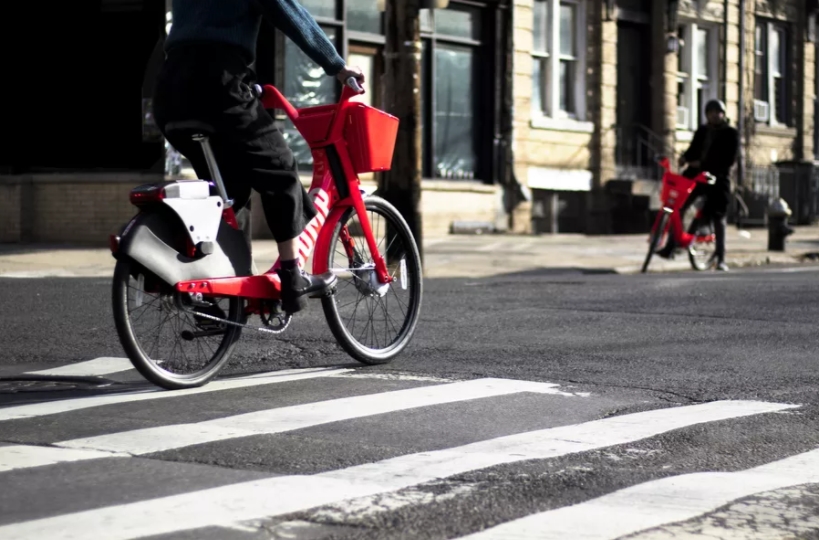
Jump Bikes launched in San Francisco in January with 250 electric bikes. By February, Jump had launched a pilot service in partnership with Uber. By the end of February, its first full month of operation, the company said each of its bikes saw up to four trips per day at an average distance of 2.6 miles.
That’s as many as 1,000 trips a day or 28,000 trips that month. In other words, those are 28,000 trips that Uber could have gotten a bigger piece of.
So it came as little surprise when Uber announced on Monday it was acquiring Jump. The company would not disclose the terms of the transaction.
The introduction of dockless electric scooters and bikes posed a clear threat to one aspect of Uber’s ride-hail business: Shorter trips.
In Santa Monica, for example, Uber is fending off scooter-sharing company Bird. The company, founded by former Uber executive Travis VanderZanden, completed 500,000 trips between September 2017 and March 2018. Bird is also now available in San Francisco.
Losing out on trips shorter than three miles may not seem like much on the surface, but it certainly adds up. In San Francisco, a three-mile Uber ride between the Financial District and the Mission could cost between $5 and $13, at the time of publication. (The price varies based on things like time of day, demand and other market dynamics.)
In China, where dockless bike-sharing first took off, there were more bike-share rides between 2013 and 2017 than there were ride-share rides in the U.S. in that time. So there’s a big potential market for Uber to crack with e-bikes.
The company is already fending against both public transit and competitors like Lyft; operating a service that could make it easier and cheaper to take shorter rides could mitigate a new threat to Uber’s business.
Under the right circumstances — like weather, time, availability and price — taking a $2 bike ride may be the optimal option for passengers. That’s especially true of electric bikes that can be dropped off anywhere because it offers the convenience of a door-to-door service that does not require much more physical exertion for a typically much cheaper price.
For that trip between the Financial District and the Mission, transportation options include:
- Taking public transit, such as BART, for between $2 and $2.50
- Taking Lyft
- Taking an Express Pool for just under $5, but you have to walk to meet your driver and potentially get matched with other riders
- Taking an Uber Pool for about $6 will get you dropped off at your door but also potentially matches you up with other passengers
- Taking UberX for about $13 door to door with no other passengers
- Finding the nearest electric bike and riding it for $2 if it takes you less than 30 minutes to bike that trip. You then drop off the bike in front of your destination.
(All of these Uber prices reflect what is currently quoted in the app and is subject to change.)
E-bikes won’t always be the best solution — especially if they’re not available nearby — but it does open up a variety of use cases that Uber may not have been able to access without subsidizing the cost of the rides. For instance, riders will be able to bike to and from public transit stops that don’t have a nearby docked bike-share system.
Taking an Uber to a transit stop may not seem feasible to those who are price sensitive, which means without a product like bike-sharing, Uber could have a difficult time taking a piece of those first- and last-mile trips in a meaningful way.
Additionally, the combination of dockless, electric bikes and Uber could make it easier for some users to access the ride-hail company’s other car-hailing services.
Taking a $2 bike into a part of the city with a higher density of drivers and then hailing an Uber from there may be a faster and more affordable option than taking an Uber for that whole ride. In cities and countries with smaller streets and alleyways, users can now take a quick bike ride to a place where they can more easily hail an Uber.
Uber is also better positioning itself to compete with international players like Ola, which is testing its own bike-share service. Bike-share is taking off in markets around the world especially in places where local governments are growing increasingly concerned about pollution. This is a big opportunity for Uber to expand its footprint in most markets.
It’s not exactly cheap, however. While Uber does not have to pay for the costs of expensive docks, the company has to now own and maintain these electric bikes and either hire or contract people to move the bikes around and charge them.
The company will have help in attempting to operate the bike-share system effectively, of course. Jump Bikes, founded by Ryan Rzepecki, has been operating in the bike-share space for 10 years and initially focused on selling these bikes to clients in 40 markets.

